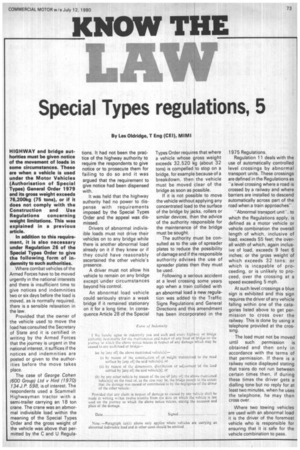Special Types regulations, 5
Page 75

If you've noticed an error in this article please click here to report it so we can fix it.
By Les Oldridge, T Eng (CEO, MIMI HIGHWAY and bridge authorities must be given notice of the movement of loads in some circumstances. These are when a vehicle is used under the Motor Vehicles (Authorisation of Special Types) General Order 1979 and its gross weight exceeds 76,200kg (75 tons), or if it does not comply with the Construction and Use Regulations concerning weight limitations. This was explained in a previous article.
In addition to this requirement, it is also necessary under Regulation 26 of the Special Types Order to give the following form of indemnity to such authorities.
Where combat vehicles of the Armed Forces have to be moved urgently in the national interests and there is insufficient time to give notices and indemnities two or six days before the load is moved, as is normally required, there is a sensible relaxation in the law.
Provided that the owner of the vehicle used to move the load has consulted the Secretary of State and it is certified in writing by the Armed Forces that the journey is urgent in the national interest, it suffices if the notices and indemnities are posted or given to the authorities before the move takes place.
The case of George Cohen (600 Group) Ltd v Hird (1970) 134 J. P. 598, is of interest. The respondents used a Scarnmell Highwayman tractor with a semi-trailer carrying an 18 ton crane. The crane was an abmor mal indivisible load within the meaning of the Special Types Order and the gross weight of the vehicle was above that permitted by the C and U Regula tions. It had not been the practice of the highway authority to require the respondents to give notice or to prosecute them for failing to do so and it was argued that the requirement to give notice had been dispensed with.
It was held that the highway authority had no power to dispense with requirements imposed by the Special Types Order and the appeal was dismissed.
Drivers of abnormal indivisible loads must not drive their vehicles on to any bridge while there is another abnormal load already on it if they knew or if they could have reasonably ascertained the other vehicle's presence.
A driver must not allow his vehicle to remain on any bridge except under circumstances beyond his control.
An abnormal load vehicle could seriously strain a weak bridge if it remained stationary on it for a long time. In consequence Article 28 of the Special Types Order requir s that where a vehicle whose dross weight exceeds 32,520 Ng (about 32 tons) is compelled to stop on a bridge, for example! because of a breakdown, then j the vehicle must be moved blear of the bridge as soon as possible.
If it is not possible to move the vehicle withoutapplying any concentrated load to the surface of the bridge by jacks, rollers or similar devices, then the advice of the authority responsible for the maintenance of the bridge must be sought.
The authority must be consulted as to the use of spreader plates to reduce the possibility of damage and if the responsible authority advises the use of spreader plates then they must be used.
Following a serious accident at a level crossing some years ago when a train collided with an abnormal load a new regulation was added to the Traffic Signs Regulations and General Directions and this amendment has been incorporated in the 1975 Regulations.
Regulation 11 deals with the use of automatically controlled level crossings by abnormal transport units. These crossings are defined in the Regulations as "a level crossing where a road is crossed by a railway and where barriers are installed to descend automatically across part of the road when a train approaches-.
"Abnormal transport unit", to which the Regulations apply, is defined as a motor vehicle or vehicle combination the overall length of which, inclusive of load, exceeds 55 feet; the overall width of which, again inclusive of load, exceeds 9 feet 6 inches, or the gross weight of which exceeds 32 tons; or which is incapable of proceeding, or is unlikely to proceed, over the crossing at a speed exceeding 5 mph.
At such level crossings a blue sign is exhibited and this sign requires the driver of any vehicle falling within one of the catagories listed above to get permission to cross over the railway. This is done by using a telephone provided at the crossing.
The load must not be moved until such permission is obtained and then only in accordance with the terms of that permission. If there is a railway notice displayed stating that trains do not run between certain times then, if during these times the driver gets a dialling tone but no reply for at least two minutes, when he uses the telephone, he may then cross over.
Where two towing vehicles are used with an abnormal load it is the driver of the foremost vehicle who is responsible for ensuring that it is safe for the vehicle combination to pass.












































































































































